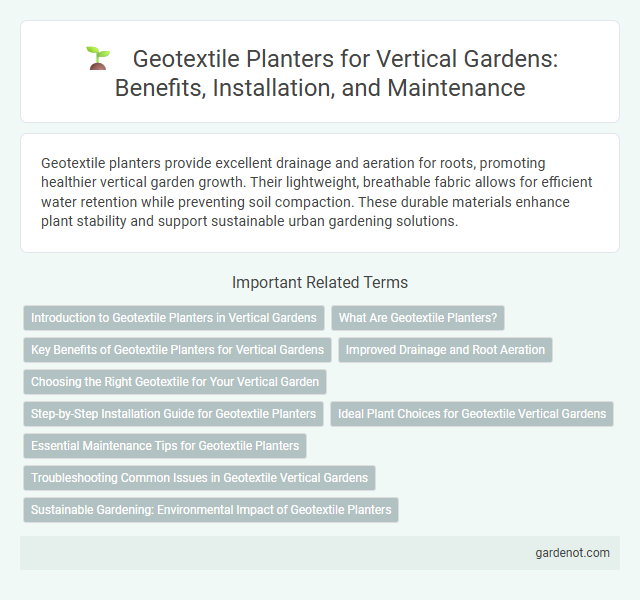Geotextile planters provide excellent drainage and aeration for roots, promoting healthier vertical garden growth. Their lightweight, breathable fabric allows for efficient water retention while preventing soil compaction. These durable materials enhance plant stability and support sustainable urban gardening solutions.
Introduction to Geotextile Planters in Vertical Gardens
Geotextile planters offer an innovative solution for vertical gardens by providing breathable, durable fabric containers that promote healthy root growth and efficient water drainage. These flexible planters are made from high-strength, permeable materials that prevent soil erosion while allowing air and moisture to reach plant roots, enhancing overall plant vitality. Their lightweight and modular design make geotextile planters ideal for creating sustainable, space-saving green walls in urban environments.
What Are Geotextile Planters?
Geotextile planters are specially designed fabric containers made from permeable materials that allow water and air to flow through, promoting healthy root growth in vertical gardens. These planters enhance drainage and prevent soil erosion while providing a lightweight and durable solution for planting in vertical spaces. Their breathable structure supports optimal moisture retention and nutrient distribution, making them ideal for sustainable vertical garden installations.
Key Benefits of Geotextile Planters for Vertical Gardens
Geotextile planters enhance vertical gardens by promoting superior drainage and aeration, preventing root rot and ensuring healthy plant growth. Their durable, breathable fabric supports optimal moisture retention while allowing excess water to escape, reducing the risk of overwatering. Lightweight and flexible, geotextile planters simplify installation and maintenance in vertical garden systems, making them an eco-friendly and space-efficient solution.
Improved Drainage and Root Aeration
Geotextile planters in vertical gardens enhance drainage by allowing excess water to pass through while retaining sufficient moisture for plant roots. Their porous fabric structure promotes efficient root aeration, preventing root rot and encouraging healthy root growth. This combination supports robust plant development and reduces maintenance requirements in vertical gardening systems.
Choosing the Right Geotextile for Your Vertical Garden
Selecting the ideal geotextile for your vertical garden depends on factors like permeability, durability, and UV resistance to ensure optimal plant health and structural support. Non-woven geotextiles are preferred for their excellent water retention and air permeability, promoting root growth while preventing soil erosion. Consider high-quality polypropylene or polyester fabrics that balance strength and flexibility, enhancing the longevity and efficiency of your vertical garden system.
Step-by-Step Installation Guide for Geotextile Planters
Begin the installation by securely attaching the geotextile fabric to the vertical structure using galvanized staples or screws with washers to prevent tearing. Fill each pocket with a lightweight, well-draining soil mix rich in organic matter to promote healthy root growth and efficient water retention. Finally, plant drought-tolerant greenery suited for vertical gardens and irrigate evenly with a drip irrigation system to ensure consistent moisture without waterlogging.
Ideal Plant Choices for Geotextile Vertical Gardens
Succulents, ferns, and herbs thrive in geotextile vertical gardens due to their low water requirements and adaptability to thin growing mediums. Air plants and trailing vines like pothos or philodendron are also ideal as they easily anchor to the fabric and maximize vertical space. Selecting drought-tolerant and lightweight species ensures optimal growth and longevity in geotextile planters.
Essential Maintenance Tips for Geotextile Planters
Regularly inspect geotextile planters for clogs and ensure proper drainage to prevent waterlogging and root rot. Remove accumulated debris and prune plants to maintain healthy growth and airflow within the vertical garden structure. Use organic mulch and check fabric integrity periodically to extend the lifespan and functionality of geotextile materials.
Troubleshooting Common Issues in Geotextile Vertical Gardens
Geotextile planters in vertical gardens often face drainage problems leading to root rot and mold growth due to water retention within fabric layers. Ensuring proper installation with adequate drainage layers and selecting high-permeability geotextile materials can prevent soggy soil conditions. Regular inspection for fabric tears and nutrient buildup helps maintain healthy plant growth and prolongs planter lifespan.
Sustainable Gardening: Environmental Impact of Geotextile Planters
Geotextile planters play a crucial role in sustainable gardening by enhancing water retention and reducing soil erosion in vertical gardens, thereby minimizing environmental impact. Made from biodegradable or recyclable materials, these planters contribute to resource conservation and lower carbon footprints compared to traditional plastic pots. Their permeability supports healthy root aeration, promoting plant growth while maintaining eco-friendly practices in urban green spaces.
Geotextile planter Infographic

 gardenot.com
gardenot.com